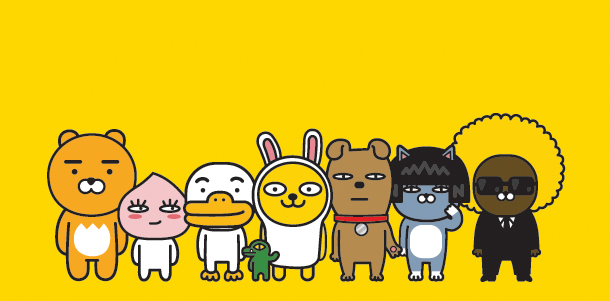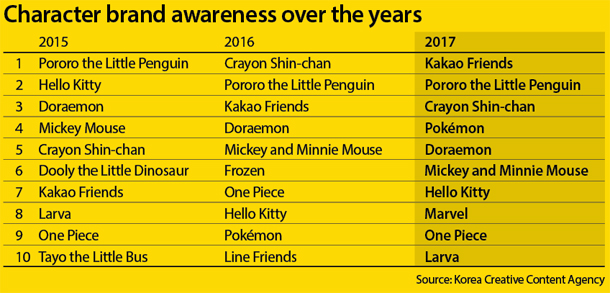The Kakao Friends are the country’s favorite characters

The Korea Creative Content Agency, or Kocca, every year asks survey participants to name the top three characters that pop into their heads.
Participants mentioned the Kakao Friends 32.2 percent of the time in 2017, compared to 21.4 percent in the previous year. The chat app’s mascots rose from seventh place in 2015 to third place in 2016 before coming in first last year.
The characters are a diverse group of anthropomorphic animals, fruits and vegetables, and as Kakao Talk grows in popularity, so have the Friends. They are buoyed by the company’s chain of Kakao Friends stores, which sell merchandise ranging from stationery to plush toys decorated with the colorful characters.
Prominent brands like KFC and The Face Shop have recently collaborated with Kakao Friends to launch new products, hoping to benefit from their popularity.
Line Friends, the mascots of Naver’s rival messaging app Line, took 10th place in 2016, but were pushed out of the top 10 last year.
The second most popular character of 2017 was Pororo, the protagonist of the Korean children’s animated TV series “Pororo the Little Penguin.”

Pororo first aired on the educational TV channel EBS in 2003, and quickly won the hearts of children all across the country. Many Korean parents call the penguin “President Pororo” because of the show’s unique ability to catch kids’ attention.
Crayon Shin-chan, a mischievous Japanese kindergartner who stars in movies and his own TV show, came in third place.
In 2017, Shin-chan was mentioned by 19.3 percent of the respondents, a 3 percent drop compared to 2016, when he came in first. Though originally intended for adult viewers, the show has been tremendously popular across many age ranges since it first aired in 1992.
Other Japanese characters were ranked highly as well, attesting to their influence in the Korean entertainment world. No. 4 Pokemon first entered the world as a Japanese children’s game in 1995. Both No. 5 Doraemon and No. 9 One Piece were originally Japanese cartoons that went on to enjoy decades of popularity in other mediums.
Hello Kitty, which came in at seventh place, was created by Japanese design company Sanrio in 1975 as a cute design to add value to merchandise. Over the years, the iconic cat character gained fans all across the world, and now generates billions of dollars a year in sales for Sanrio.
Walt Disney’s Mickey Mouse came in sixth and Marvel characters claimed eighth place. Marvel superheroes have grown increasingly popular in Korea due to the domestic success of their blockbuster films.
“The market for characters, which was previously geared toward children, is expanding to audiences of every gender and age,” explained Song Yo-sep, who manages policy at Kocca. “The related industry is growing as well. Characters make up an important part of the domestic content business, and they are expected to create synergy when combined with other industries.”
BY CHOI HYUN-JU [kim.eunjin1@joongang.co.kr]










with the Korea JoongAng Daily
To write comments, please log in to one of the accounts.
Standards Board Policy (0/250자)